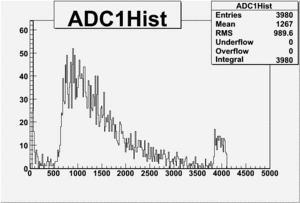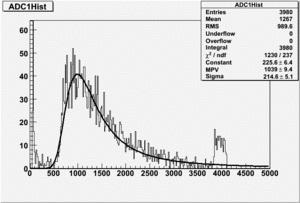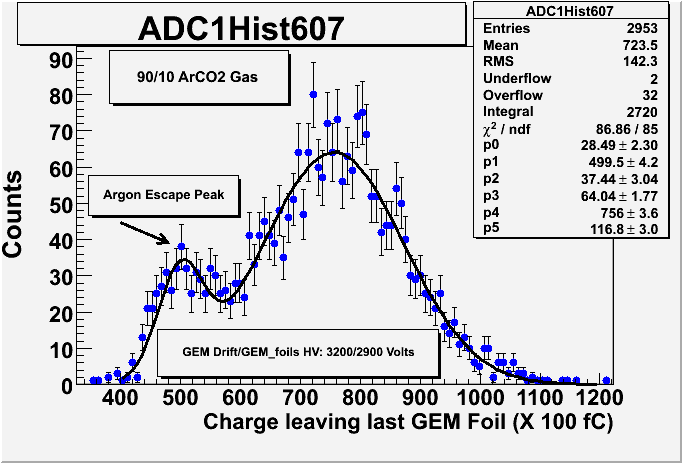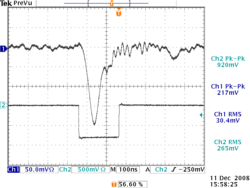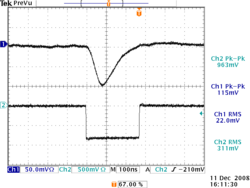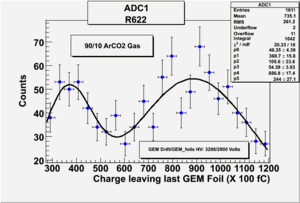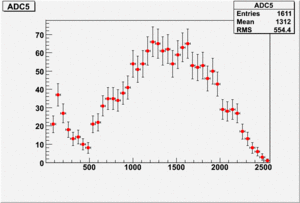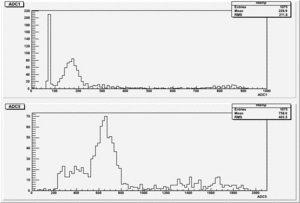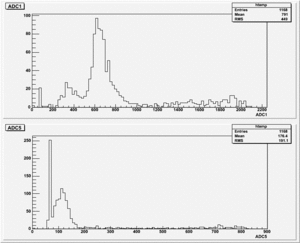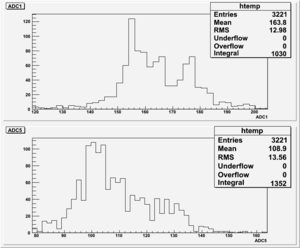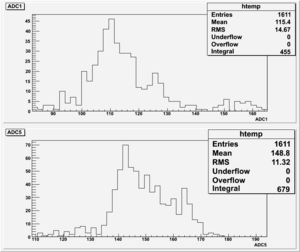Difference between revisions of "GEM Cosmic V792 Measurements"
| Line 85: | Line 85: | ||
I used the attenuator for both channels and it was set to the same value: 12dB = 10.7918. | I used the attenuator for both channels and it was set to the same value: 12dB = 10.7918. | ||
| − | ==Gain | + | ==Gain Calculation== |
Dr. Forest, I still used my way to find out the gain. It is not accurate, but below are shown some first calculations(i think that is the right way to do that):<br> | Dr. Forest, I still used my way to find out the gain. It is not accurate, but below are shown some first calculations(i think that is the right way to do that):<br> | ||
Revision as of 08:04, 13 December 2008
11-07-08
The pulse coming from the strips is delayed and amplified using the Timing Filter Amplifier Model_474(X6). The amplified pulse is connected to the V792 QDC.
Run 550
Start Time: Nov 6 19:58:03; End Time: Nov 7 09:45:57
12-10-08
The signal below represents a measurement of the Trig out signal from a 10 cm x 10 cm ionization chamber with 3 GEM preamplifiers. The chamber gas a 90/10 % mixture of Arcon and CO2. The Drift HV was set to 3200 Volts and the GEM preamplifier HV distribution network was set to 2900 Volts. The V792 CAEN ADC channels have a gain of 100 fC/channel. The main signal peak appears at channel number 759 and represents an accumulation of pC of charge.
Electronics Settings:
TrigOut goes to Timing Filter Amplifier(Coarse Gain=X6, Fine GAin=7.5ns && Integrate=20ns) and after amplification to ADC
StripOut is used as a trigger and gate. The signal from the strip is amplified by the Timing Filter Amplifier (Coarse Gain=X20, Fine Gain=12.5ns && Integrate=500ns)
The Threshold on DIFF. CFD is set to 0.70 (ULD=9.9~10 && LLD=0.5)
12-10(11)-08
HV Settings: Volts and Volts.
Using again only TrigOut and the signal from the Strip.
Electronics Setup: done (might change CFD threshold)
12-11-08
HV Settings: Volts and Volts.
Gas type 90/10 ArCO2.
Electronics Setup
TrigOut and the stripsignal, both are used as a pulse and go to ADC.
The pulse from the Strips is used as a trigger and gate.
The pulse from the trigout is delayed, Amplified by the Timinig Filter Amplifier(Coarse_Gain=X20, Fine_Gain=8.5 && Integrate=20ns).
Signal from the Strips goes to the Timing Filter Amplifier(Coarse_Gain=X20, Fine_Gain=10.5 && Integrate=20ns). Amplified pulse is devided into two signals, One is sued as a trigger and gate and second as a pulse for ADC. The first one(gate && trigger) is amplified using the Timing Filter Amplifier(Coarse_Gain=X2, Fine_Gain=10 && Integrate=50ns) and used in DIFF. CFD for gate and trigger. Second output from the Amplified strips, goes to delay box(TENNELEC TC 215 DELAY AMPLIFIER) and putted to the ADC.
The results shown below are for different Diff. CFD values.
1). Threshold Values: Threshold=1.90, ULD=9.65 && LLD=2.10
Run Number is r613
Start time: Dec 11 16:31:42 End Time: Dec 11 17:32:23
2). Threshold Values: Threshold=3.10, ULD=9.65 && LLD=2.90
Run Number is r622
Start time: Dec 11 19:25:28 End Time: Dec 11 21:53:44
2). Threshold Values: Threshold=3.70, ULD=9.65 && LLD=3.50
Run Number is r624
Start time: Dec 11 21:58:37 End Time: Dec 12 12:19:53
12-12-08
Finding out what is gain for each channel using the Stanford pulse generator.
Setting:
Run Number: r634 && r635
Original pulse from stanford pulse generator goes to the ADC: r636 && r637
I used the attenuator for both channels and it was set to the same value: 12dB = 10.7918.
Gain Calculation
Dr. Forest, I still used my way to find out the gain. It is not accurate, but below are shown some first calculations(i think that is the right way to do that):
Gain_for_Channel_1 = Gain_TrigOut =
Gain_for_Channel_5 = Gain_Strip =
